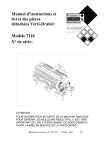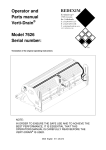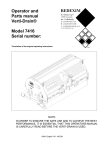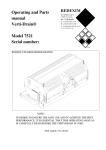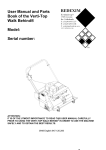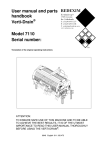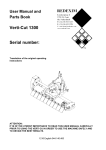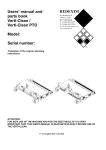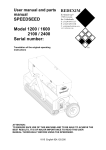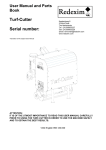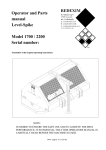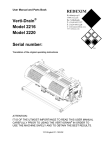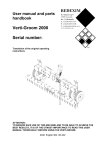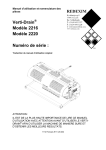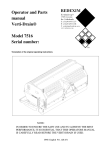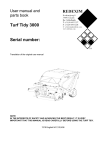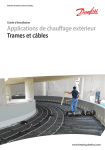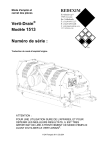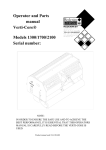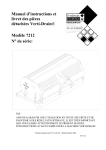Download User manual and parts handbook Verti
Transcript
User manual and parts handbook Verti-Drain® 7007 Hydro Model Serial number: Translation of the original operating instructions ATTENTION: TO ENSURE SAFE USE OF THIS MACHINE AND TO ACHIEVE THE BEST RESULTS, IT IS OF THE UTMOST IMPORTANCE TO READ THIS USER MANUAL CAREFULLY BEFORE USING THE VERTI-DRAIN®. 0948 English 911.120.402 FOREWORD Congratulations on your purchase of the Verti-Drain®. To ensure the long and safe use of ® this Verti-Drain , it is of the utmost importance for all those who will be using it to read and understand this user manual. Operation of this machine is not safe without full knowledge of the content of the manual. ® The Verti-Drain is solely intended for use on lawns and other areas where grass could grow. On the next page you will first find the general safety instructions. Every user must know and apply them. After this, a registration card is included. This card should be returned for handling any future claims. This user manual offers many instructions numbered in sequence. This sequence should be observed. An asterisk * indicates a safety instruction. An @ indicates a tip and/or note. All information and technical specifications provided at the moment that this document is published are the most recent ones. Design specifications may be changed without prior notice. This document is a translation of the original operating instructions. Upon request, the original operating instructions are available in Dutch. GUARANTEE CONDITIONS ® THIS VERTI-DRAIN IS DELIVERED WITH A WARRANTY AGAINST DEFECTS IN MATERIALS. THIS GUARANTEE IS VALID FOR A PERIOD OF 12 MONTHS FROM THE PURCHASING DATE. VERTI-DRAIN® WARRANTIES ARE SUBJECT TO THE “GENERAL CONDITIONS FOR SUPPLY OF PLANT AND MACHINERY FOR EXPORT, NUMBER 188”, WHICH ARE PUBLISHED UNDER THE AUSPICES OF THE UNITED NATIONS ECONOMIC COMMISSION FOR EUROPE. REGISTRATION CARD For your own information, please complete the table below: Serial number of machine Dealer name Purchasing date Remarks 2 ! Fig.1 SAFETY INSTRUCTIONS ! The design of the Verti-Drain® allows for safe use. However, this is only possible if the user fully observes the safety instructions given in this manual. Read and understand (Fig. 1) the manual before starting to use the Verti-Drain®. If the machine is not used as described in the ® manual, injury and/or damage to the Verti-Drain may result. (1) The Verti-Drain® is solely intended for the treatment of lawns or other areas where grass should grow. Any other use is considered to be incorrect use. The manufacturer accepts no liability whatsoever with regard to damage resulting from such incorrect use; all resulting risks are the responsibility of the user. Correct use also includes following the manufacturer’s usage, maintenance and repair instructions. Before using the Verti-Drain®, inspect the area to be treated. Remove any loose obstacles and avoid irregularities. (2) The Verti-Drain® was constructed according to the latest technological knowledge and is safe to use. Improper use, maintenance or repair of the machine may result in injury to both the user and others. This should be avoided! (3) All persons whom the owner assigns to operate, maintain or repair the VertiDrain® must read and have completely understood the operating manual and in particular the section Safety Instructions. The user is responsible for the safe use of the Verti-Drain®. The whole unit must be tested in terms of noise, safety and ease-of-use. In addition, user’s instructions must be prepared. (4) Before using the Verti-Drain®, the user is obliged to inspect it in terms of visible damage and defects. Any changes in the Verti-Drain® (including its functioning) that may affect its safety must be corrected immediately. For reasons of safety, it is in principle forbidden to make changes in or additions to the Verti-Drain® (with the exception of those approved by the manufacturer). ® If any modifications have been made to the Verti-Drain , the present CE certificate becomes null and void and the person who made the modifications should himself ensure a new CE certificate is granted. Before each use, inspect the Verti-Drain® for loose bolts/nuts/parts. Regularly check the hydraulic hoses and replace them when they are damaged or show signs of wear. The replacement hoses must meet the manufacturer’s technical specifications. Before carrying out any activities on the hydraulic installation, the pressure should always be released. 3 ® NEVER use de Verti-Drain if its protective covers and safety stickers are missing. ® NEVER step off the Verti-Drain while the engine is still running. The motor should cut out automatically when pressure is no longer exerted on the seating area when you dismount. If this is not the case, switch off the engine and ® engage the foot brake of the Verti-Drain before dismounting from the Verti® Drain . The use of the foot brake is described further on in this manual. Therefore, check beforehand the cabling and the seat switch to ensure they work correctly. When carrying out maintenance, adjustments or repairs, ensure the Verti-Drain® is blocked from sagging/moving/sliding. Before carrying out maintenance, adjustments and repairs always first switch off the engine and remove the key from the ignition (Fig. 2) Fig.2 When carrying out any maintenance or repairs, ensure you use original VertiDrain® parts only. This will ensure continued safety of the machine and its user. Only authorised technical personnel may carry out adjustments and repair work to the Verti-Drain®. Keep an overview of repairs. (5) In addition to the instructions in this user manual, the generally applicable regulations with respect to safety and working conditions must be followed. It may not be used on the public highway. For information on transportation, please refer to Section “Transportation of the Verti-Drain®.” Transporting persons is not permitted! Do not use the Verti-Drain® when it is dark, during heavy rain/ storms, or on slopes with a gradient greater than 20 degrees. 4 ® (6) Before starting to work, all persons who will operate the Verti-Drain must be familiar with all its functions and controls. On both sides of the Verti-Drain® on the sideboard, there are safety stickers (Fig. 3,4,5) and on the back cover (Fig. 6) with the same meaning. Ensure these safety stickers are always clearly visible and legible. Replace them if they are damaged. During operation, ensure there are NO persons in the danger area except the driver of the Verti-Drain®, because they may be injured by moving parts. (Fig. 3) fig.4 fig.3 Remain at least 4 metres away! (Fig. 4) The back cover must always be closed and undamaged during operation of the machine! (Fig. 5) Be careful not to get pinched! (Fig. 6) Be careful! Hot surface! (Fig. 7) Use certified ear protection when using the machine! (Fig. 7a) Fig. 5 Fig. 7 Fig. 6 Fig. 7a Wear suitable clothing. Wear sturdy shoes with a steel tip, wear long trousers, do up long hair and wear no loose clothing. 5 (7) Location of safety stickers. (Fig. 8) Fig. 8 Used oil/grease is harmful to the environment; dispose of it according to locally applicable regulations. 6 CONTENTS Section Description Page Foreword 2 Guarantee conditions 2 Registration card 2 Safety instructions 3 1.0 Technical data 8 2.0 First installation 9 2.1 Initial Adjustment of Speed Pedal 11 3.0 General parts list 12 4.0 Adjusting the operating depth 14 5.0 Pin angle adjustment 15 6.0 Start/stop procedure 16 7.0 Operation of the Verti-Drain ® 17 ® 8.0 Transportation of the Verti-Drain 17 9.0 Operation of the pedal/driving speed 18 10.0 Operation of the brake pedal/parking brake 19 ® 11.0 Blocking the Verti-Drain unit 20 12.0 Disconnect V-belts 21 13.1 Troubleshooting 13.2 Verti-Drain unit troubleshooting 23 14.0 Maintenance 24 15.0 EU certificate 24 16.0 Technical information 25 16.1 The crankshaft 25 16.1.1 Replacement of a crank crank / crank bearing 25 16.1.2 Releasing crankshaft tension 26 16.2 Torque values 26 16.3 Alignment of an element 27 16.4 Timing of the crankshaft elements 27 16.5 Replace the V-belt drive 28 22 ® ® 16.6 Tensioning the Verti-Drain unit V-belt drive 29 16.7 Correct adjustment of the pedal 30 16.8 Chain drive of the back wheel 31 16.9 Adjusting the hydraulic system pressure Options, Turf hold-down kit 31 17.0 17.1 Options, tines 33 17.1.1 Solid tines 33 17.1.2 Hollow tines 34 17.1.3 Multi-tine kit 34 17.1.4 Cross tines 34 17.2 Options, core collector 34 17.3 Options, rear roller 34 17.4 Options, 3-wheel Drive (3WD) 35 32 Parts pages 7 1.0 TECHNICAL DATA Model 7007 Hydro Working width 675 mm (26.5”) Operating depth Up to 150 mm (6”) Max. speed Theoretically 10.6 km/hour (6.59 miles/hour) Weight 745 Kg (1620 lbs) Hole separation between the tines Hole separation in driving direction Maximum capacity 55 mm (2 1/8”). 55 mm (2 1/8”) or larger. Engine 1,114 m²/hour (11,990 ft² /hour) with a square hole pattern. 2,030 mm x 1,100 mm x 1,250 mm (81.2” x 44” x 50”) Solid 12 x 150 mm (1/2”x 6”) Hollow 19 x 150 mm (3/4”x 6”) 18 HP, electric starter, max. 3000 rpm. Engine oil SAE 30. Hydraulic oil Oil tank contents Shell Naturelle Fluid HF-E biodegradable oil or similar. 20 litres Lubricant EP 2 Minimal tyre pressure Front: 1 bar (14.5 PSI) Rear: 0.5 bar (7.25 PSI) Set of solid tines 8 x 150 mm (5/16” x 6”) with adapters. Front roller with depth adjustment. Toolbox with tools and user manual. Solid tines. Hollow tines. Cross tines. Turf hold down fingers. Core collector. Rear roller. 3-wheel drive. Shipping dimensions Maximum tine size Standard parts Options 8 2.0 FIRST INSTALLATION Fig. 9 The machine will be delivered on a pallet and will have been attached with bolts at the front and the rear. The back wheels, the related brakes and scrapers and the tines will have been supplied separate with the machine. 20 21 22 29 23 24 28 27 1 19 26 2 18 17 25 16 14 15 3 4 5 6 7 8 9 10 11 12 13 Fig. 10 The machine can be prepared as follows: 1. Remove all separate parts from the machine. 2. Mount the two back wheels, the two brake designs and the two scrapers that have been supplied separately. Mount the brakes and back wheels as follows: (see fig.10) - Brake cable 1 has already been installed and only needs to be attached to the brake and adjusted once the brake has been mounted. 9 - Remove the nuts that have been used as standard to secure bearing 2. Replace them by long nuts 4 and 5 that have been supplied. Nut 4 has been unscrewed and must fit in plate 3. - Base plate 18 can be attached to nuts 4 and 5 by using bolts 7 and rings 8. Simultaneously mount handle 19. NOTE: A left- and a right-hand version has been supplied of handle 19. The handle must point backwards when mounted. - Mount plate brake shoe 10 using two bolts 12, two rings 11, two spacers 17 and two nuts 6 on base plate 18. - Attach brake spring 16 to both brake shoes 9 and “press/bend” the brake shoes around the flat side of handle 19 and mounted plate 10. - Wheel shaft assembly 13 can be slid into bearing 2. Do not forget to secure conical bushes 23 around the shaft on both sides of bearing 2. NOTE: Ensure that the splines of shaft 13 match the sprocket wheel. If this is difficult, adjust the chain tension at a slightly lower value. - Wheel shaft 13 must not protrude from conical bush 23 on the Verti-Drain® side. The end of shaft 13 must be the same as the end of conical bush 23. - Check the working of the brake by manually energising handle 19. The handle should move smoothly. If the brake works correctly, attach brake cable 1 to the handle using bolt 22, nut 21 and check nut 20. - Check that all components have been tightened correctly. - Next, adjust the brake cables in such a way by using nuts 24 that the brake pedal/parking brake brakes correctly. The brake cables can also be adjusted under the pedals but making the adjustments at the back wheels is preferable. - Finally, mount two back wheels 15 using wheel nuts 14 on wheel shaft 13. - Mount both scrapers. First mount fixing bracket 26 using nut 27 on the back beam of the Verti-Drain®. Next, mount scraper 28 using bolts 29 and nuts 25 to fixing bracket 26. 3. 4. 5. 6. 7. Mount the front wheel. Check the engine oil. Check the hydraulic oil. Check the machine for damage and loose parts, bolts and nuts. Remove the pallet of the machine. * Do not crawl under the machine. * Ensure that the machine is hoisted using solid suspension points to avoid damage to the machine. * Ensure that the cable/crane/lift can lift at least 1,000 kg (2205 lbs). 8. Mount the tines. Fig. 11 10 2.1 Initial Adjustment of Speed Pedal 1 90 mm 2 6 3 4 5 BOTTOM VIEW The speed pedal will be set at the factory, but is important for your own safety to check this before starting the machine the first time. Check as following: - - Lift up the rear wheels of the unit and block securely (for 3-wheel drive version, lift all wheels off ground). Check height of the speed pedal (90 mm) if not, correct by making rod 5 longer or shorter. Check if the speed pedal will have free play, if so adjust item nr 2 so that you do not have any free play left in the pedal. Move the pedal a few times forward and backward, and check if it still comes back in neutral position. Start the engine and push the speedpedal complete forward. Release the pedal and it should come back to neutral. If the wheels still move forward or backward in neutral, you have to adjust rod nr 3. If the wheels still move forward, shorten the rod nr 3. If the wheels still move backwards make the rod a little longer. When you have checked this, you can lower the machine onto the wheels and test drive. 11 15 23 6a 14 22 25 4 6 13 30 10 5 1 21 24 7 2 20 3 16 17 12 26 19 27 11 28 29 9 8 31 18 Fig. 12 3.0 GENERAL PARTS LIST Figure 12 shows some important general parts: 1. Safety sticker 900.280.402 , read user manual before use/Toolbox with tools and manual. 2. Safety sticker 911.280.402: keep a distance of at least 4 metres from the machine. Stop the engine before carrying out repairs or adjustments. 3. Safety sticker 911.280.404, the back cover must always be closed and undamaged during operation of the machine! 4. Safety sticker 900.280.404, Be careful not to get pinched when opening the rear cover! 5. Safety sticker 900.280.406, Be careful! Hot surface! 6. Safety sticker 911.280.406, Parking brake. 6a. Safety sticker 911.340.408, Safety decal noise. * Ensure all stickers are clearly visible on the machine and are understood. 12 A number of important parts on the prime mover: 7. The engine. 8. The hydraulic pump. 9. The hydraulic motors. 10. The battery. 11. The driving pedal. 12. Tine distance speed adjustment. 13. The brake pedal/parking brake. 14. Starter switch. 15. Throttle. 16. Verti-Drain® unit operation handle. 17. Hydraulic oil filling point. 18. Oil tank. 19. Path guidance indicators. 20. Adjustable scrapers. 21. Starter cord. 22. Choke. 23. Blocking mechanism for folding the seat. 24. Hour/revolution counter. 25. Blocking strip for the Verti-Drain® unit. A number of important parts on the Verti-Drain® unit: 26. The serial number is on the inside of the machine. 27. Operating-depth indicator. Attention: the indication is based on the maximum length of the tines. 28. Tine angle adjustment handle. 29. The front roller. It can be adjusted in height. 30. Knob for securing the back cover of the Verti-Drain®. 31. The toplink. 13 3 3 2 4 1 Fig. 13 4.0 OPERATING DEPTH ADJUSTMENT Carry out the following to adjust the operating depth: (see fig. 13) 1. Lift the Verti-Drain® unit to the highest position. 2. Block the whole machine with the foot brake in the parking position. 3. Switch off the Verti-Drain® and remove the key from the ignition. 4. Untighten the bolts (1) a little. Be careful. Do not loosen too much since then the bolts will fall out from the locking strip (2). 5. Adjust the height of the front roller by turning clock- or counter clockwise the spindles (3). Each rotation is 4 mm (0.16”). The sticker (4) on the side of the machine gives the depth setting. 6. When the required height has been reached, re-tighten the bolts (1). @ Never adjust one side by more than 4 turns. Before continuing, compensate the other side. @ A spanner is included in the machine’s toolbox. @ The depth adjustment on the stickers only applies when 150 mm (6”) long tines are used. When shorter tines are used, subtract the difference in length, compared to 150 mm (6”), from the value shown on the stickers. @ The spindle and the nut must be cleaned every 100 hours and sprayed with thin oil that does not attract dirt. 14 2 1 3 4 Fig. 14 5.0 Tine angle adjustment The tine angle of all tines can be adjusted by changing the angle of the central adjustment shaft. This should be done as follows: (See fig.14) Lift the Verti-Drain® unit to the highest position. Block the whole machine with the foot brake in the parking position. Switch off the Verti-Drain® and remove the key from the ignition. Slightly loosen the nuts (1) on both sides so that the central adjustment shaft (4) can be turned. 5. Use the handle (2) and the sticker (3) to adjust the required tine angle. 6. Re-tighten the nuts (1) once the correct angle has been achieved. 1. 2. 3. 4. @ An angle of 90 degrees means almost no tine movement. This is required for hollow tines and is advised for the 8 mm (5/16”) tines with multi-tine blocks. @ From 90 degrees to 75 degrees means more tine movement. This is advised for solid tines and is dependent of the ground conditions, the tine size and the client’s preference. @ At 90 degrees, the tines only go straight into the ground if the machine is correctly installed, see fig. 9. If this is not correct, force F can be produced, see fig. 15, which will damage the machine. F mm 291 5" (11. ) @ The length of the assembled drawrod must be 291 mm (11.5”), which can be calibrated using shims. (See parts page.) Fig. 15 15 A Fig. 16 6.0 Start/Stop procedure To ensure the Verti-Drain® is not been damaged by wrong usage, the start and stop procedure must take place as follows: (See fig.16) Starting: 1. Drive to the place where you want to start. 2. Allow the engine to turn at a low speed. 3. Allow the Verti-Drain® unit to already drop while driving forward by pushing handle A away from you. The Verti-Drain® unit should now run automatically before the tines touch the ground. The elements must always start to turn before the tines touch the ground. If this is not the case, consult section 12.0, Troubleshooting. 4. Next, drive forwards to aerate the surface. 5. The speed can now be increased to the maximum. * Do not drive in reverse with the Verti-Drain® in the lowest position under any circumstances but first lift the Verti-Drain® to the highest position before driving in reverse. Also see section 9.0 for the operation of the accelerator and brake pedal. Stopping: 1. Lift the Verti-Drain® to the highest position by pulling lifting handle A towards you. 2. When the Verti-Drain® is in the highest position and cannot go any higher, you can release the handle. The Verti-Drain® unit should now stop running automatically. 3. You can now drive away the Verti-Drain® from its place or transport it to another location. 16 7.0 Operation of the Verti-Drain® Before the Verti-Drain® is used in the field, the following should be checked: 1. Are there any loose objects in the field? Remove these first. 2. Are there any slopes? The maximum slope this machine can work on is 20 degrees. Always work downhill. 3. Does the ground contain cables or pipes? If so, determine their depth and set the operating depth of the machine to 60% of this depth. 4. Does the ground contain hard objects? If so, use the Verti-Drain® at a low speed and adjust the operating depth. 5. Is there any danger of flying objects, such as golf balls, which may distract the attention ® of the driver? If so, do NOT use the Verti-Drain . 6. Is there any danger of sinking or sliding away? If so, postpone working with the VertiDrain®. 7. If the soil is frozen or very wet, the work should be postponed until the conditions are more favourable. 8. When the soil is very compact, use shorter tines or adjust the operating depth. 8.0 Transportation of the Verti-Drain® The Verti-Drain® may not be driven over the public road. Put the Verti-Drain® on a trailer. Use a safe trailer system to transport the Verti-Drain®. Decrease the transportation speed of the Verti-Drain® on slopes and undulating areas. You can also tow the Verti-Drain® should a trailer system not be available. The hydraulic ® system must be in neutral to tow the Verti-Drain . The handle to put the pump in neutral can be found behind the pump and can be reached through the recess from the cap on the pump side. * Ensure that you do not drive faster than 8 km/h (5 miles per hour) when towing the Verti-Drain®. If the Verti-Drain® is towed using a higher speed, the pump, hydraulic motors and other hydraulic components may suffer damage. * The position of the handle can be set vertically/horizontally with a spanner for towing purposes. Switch Horizontal = Driving Vertical = Towing 17 2 3 4 1 Fig. 17 9.0 Operation of the pedal/driving speed The Verti-Drain® has two pedals that can be found on the right side of the machine (see fig. 17). This design consists of a main speed pedal (1) and a Tine distance speed pedal (2). The main speed pedal (1) is used to take the Verti-Drain® from and to the place where the work is to be performed. Never, therefore, use this pedal when working with the machine. The Tine distance speed pedal (2) is used for performing the work. This pedal can be adjusted so that different hole distances can be achieved. To adjust this pedal, you must first unscrew the knob (3) and, next, the pedal must be turned to the required position using the adjustment handle (4). Next, the knob (3) must be re-tightened . Table 1 specifies the hole distances that can be obtained with the 5 positions. @ Attention: the hole distances in this table are at maximum speed (@ 3000 rpm). If you are working with a lower speed, the hole distances will not match the values in the table below. The data in this table should also only be regarded as providing orientation values and not absolute values. The best way to work is to try a number of settings on the variable adjustable accelerator to, thus, achieve the desired result. Table 1 Position Hole distance (mm) 1 2 3 4 5 22.5 55 77 100 110 18 1 2 Fig. 18 10.0 Operation of the brake pedal/parking brake The Verti-Drain® has two brake pedals that can be found on the left side of the machine (see fig. 18). The shorter of the two is the brake pedal (1). The long one that is also nearest to the pedal that sits on the frame is the parking brake (2) and is only used to lock the machine when it is standing still. The brake design also operates in such a way that when the brake pedal (1) has been pressed, the parking brake (2) will also have been pressed. ® To ensure that the Verti-Drain is on the parking brake (2), it must be completely pressed. The machine will remain in the brake position because the pawl will now stay behind the frame. You must press the brake pedal to take the machine off the parking brake (2). Allow the pedal to slowly come up so that the parking pedal is released from the frame through the spring at the bottom of the pedal. * Never use the parking brake as a normal brake pedal. The machine could lock unexpectedly 19 1 2 11.0 Blocking the Verti-Drain® unit Fig. 19 When the Verti-Drain® is not being used for a longer period, the Verti-Drain® unit may drop. There is a blocking mechanism on the machine to avoid this situation. When the Verti-Drain® is no longer operational, the blocking strip (1) can be turned towards the Verti-Drain® with the Verti-Drain® in the top position until it touches the bolt (2) of the turning arm as indicated in fig. 19. * Also use the blocking mechanism when working on the Verti-Drain®. 20 12.0 DISCONNECTING THE V-BELT 2 3 1 Fig. 20 The V-belt of the pump to the Verti-Drain® unit can be disconnected so that the elements are no longer running and the Verti-Drain® unit will, therefore, be at a standstill. A practical situation when this occurs is when the engine cuts out with the Verti-Drain® down and the in the ground. The best method to use to again ensure ® the Verti-Drain is removed from the ground is to disconnect the V-belt, restart the machine and, next, to lift the Verti-Drain® from the ground. Switch the machine off to again tension the V-belt. The machine can now be restarted and can be normally used. Follow the following step-by-step plan to disconnect the V-belt correctly: (see fig. 20) 1. Switch off the machine and remove the key from the ignition. 2. Block the whole machine with the foot brake in the parking position. 3. Release the idler (1) by removing the lock pin (2) so that the idler spanner (3) is released and the idler (1) can be moved down. 21 13.1 TROUBLESHOOTING Problem Possible cause The engine is not starting/is not running. The battery is dead. Wiring damaged. No fuel. No ignition. The engine will not start with the tines in the ground. Hydraulic failures. Forward movement. Back wheel is slipping. V-belt is slipping. Heavy machine steering. Too heavy a load on the starter motor. Leaks No pressure (lifting capacity) Solution Check the condition of the battery. Charge or replace the battery. Check the wiring for short circuits. Check the battery connections. Check the fuel level. Use the choke. Sit on the seat. Check the switches. Check the wiring. Check the ignition. Disconnect the V-belts. Check the components. Pump damaged. Insufficient oil. The overpressure valve has not been adjusted correctly. No pump drive. The engine will not run. The Verti-Drain® unit will not Check whether all hydraulic go down. components have been correctly connected. Check whether the blocking of the Verti-Drain® unit has been released. Accelerator is not working at Check whether the threaded rods its best. have been adjusted correctly. See Section 15.7 Check the spring. If necessary, replace it. The parking brake is not Check the adjustment of the brake. working. Check the spring. If necessary, replace it. No grip. The ground is too wet. Wait until the conditions are better. The ground is too undulating. Work on the ground in such a way that it is the least undulating. Use the 3WD option. Drive in reverse to go up hill. Attention: do not reverse while working the ground! V-belt worn. Replace the V-belts. The tension of the V-belt is Check whether the idler is working not correct. correctly and whether all retaining points for the V-belt have been mounted correctly. The drive is being Decrease it by pricking at less overloaded. depth. Tyre pressure is too low. Increase tyre pressure. Components in the steering Check the steering gear housing gear housing run out of on components that are running true. out of true and repair if necessary. 22 13.2 VERTI-DRAIN® UNIT TROUBLESHOOTING Problem Machine vibrating. Solid/hollow tines bend/break. Possible cause Crankshaft turns irregularly. Machine not at 90 degrees. Check the timing of the crankshaft. Heavy conditions. Adjust the operating depth. Use thinner/shorter tines. If conditions are dry, water soil. Change the tines, use shorter tines. Use solid tines before hollow tines to break up the ground. Adjust the operating depth. Use thinner/shorter tines. If conditions are dry, water soil. First use solid tines to break open the ground. Adjust the tine angle. Change tine size. Wrong tine selection. Heavy conditions. Front roller is not in stable contact with the ground. Solution Wrong tines, too much resistance. Heavy conditions. Damage to the drawbars. Bend/break. Damage to the turf. Oval holes. Damage to the turf. Pin not secure in pin holder. Heavy conditions. Crankshaft problems. Big-end nuts come loose. Rear roller (option) vibrates. Rear roller locked. Rear roller is raised when pricking with hollow tines. Heavy conditions. Adjust the operating depth. Adjust the operating depth. Water the soil. Machine not at 90 degrees. Central bar bent. Bearing tubes worn. Tines touch the ground when driving in reverse. Lift height not correct. Ground too wet. Change tine angle adjustment. Reduce forward speed. Adjust the operating depth. Adjust the tine angle. Use thinner tines. Mount Turf Hold Down Fingers. Use different tines. Grind a flat area on the tines. Adjust the tine angle. Eliminate the vibration, see vibration. Crankshaft bearing worn. Incorrectly installed after repair. Remove, clean, use Loctite. Unlock it. Set roller freely on the ground. Change the machine adjustments. 23 14.0 MAINTENANCE Time schedule Before each use After first 20 operating hours. (New or repaired.) Check point/lubricating point Check for loose bolts/nuts. Presence and legibility of safety stickers. Check the oil level in the engine. Check the fuel level. Check the electrical system. Lubricate the roller bearings. Check for loose bolts/nuts. After every 50 operating hours. Check the V-belt tension on Verti-Drain® unit. Inspect the machine carefully. Change the engine oil. Check oil level. Lubricate the roller bearings. Check for loose bolts/nuts. After every 500 operating hours. Check the hydraulic oil level. Fill the battery and charge it. Check the V-belt tension on Verti-Drain® unit. Inspect the machine carefully. Lubricate front roller spindles. Replace the engine oil and filter. Check oil level. Lubricate the chain drive of the back wheel. Replace hydraulic oil and filter. Method Tighten the loose bolts/nuts with the correct torque. Replace if damaged or missing. Use normal unleaded fuel. Use EP 2 lubricating grease. Tighten the loose bolts/nuts with the correct torque. Use EP 2 lubricating grease. Tighten the loose bolts/nuts with the correct torque. 4 hours at 3 amps. * See the manual for the engine for more maintenance information on the engine. 15.0 EU DECLARATION OF CONFORMITY We, Redexim, Utrechtseweg 127, 3702 AC Zeist, The Netherlands, declare entirely on our own responsibility that the product: VERTI-DRAIN® MODEL 7007 HYDRO, WITH MACHINE NUMBER AS INDICATED ON THE MACHINE AND IN THIS MANUAL, to which this declaration relates is according to the stipulation of the 2006/42/EC directive for machines. Zeist, 01/10/09 A.C. Bos Manager Operations & Logistics Redexim Holland 24 16.0 TECHNICAL INFORMATION ® Generally speaking, the Verti-Drain is not a complicated machine. A number of technical items will be explained. If you have additional questions, contact your dealer who will be happy to provide assistance. 2 1 3 4 8 5 6 2 1 7 10 9 Fig. 21 16.1 THE CRANKSHAFT The crankshaft assembly is shown in figures 21 and 22. A more detailed drawing can be found on the parts page. 16.1.1 REPLACEMENT OF A CRANK/CRANK BEARING Replacement of a crankshaft crank is necessary when it is cracked or when the nuts regularly come loose from the big-end. That is, if the crank bearings, the crankbearing fittings, or the big-end pin holes in the crank are damaged. Replace the crank/the bearing as soon as possible, to prevent additional damage to other parts, as follows: (see fig. 21) 1. Remove the big-end pin (8) and nut (9) on both sides of the crank bearing (5) so that both crank elements (3 & 6) become loose. 2. Next, remove the rings and nuts (1 & 2) on both sides of the crank elements (3 & 6). 3. Remove both crank elements (3 & 6). 4. Remove the two spacers (4). 5. Remove the profile shaft (7) with bearing (5). 6. Remove the bearing (5) of the profile shaft (7). 7. Replace the parts and assemble in the reverse order. @ Use Loctite for nuts (2 & 9). Tighten the nuts with the moment that is shown in fig. 22. 25 16.1.2 RELEASING CRANKSHAFT TENSION If parts of the crankshaft have been replaced, the crankshaft may be more difficult to turn. Pre-tension can be the cause. It is necessary to eliminate the sources of tension as follows, see fig. 21: Use a hammer to tap against the centre of the crank, starting with crank 1 located next to the V-belt drive. Do this alternately left and right from the crank. Feel whether the crank moves in the bearing and continue until the crank settles into place. Repeat this procedure for each adjacent crank until all of the cranks have settled into position and the crankshaft turns more easily. @ After repairing the crankshaft, the nuts must be checked regularly for looseness. @ Do not mount the cranks on the wrong side of the machine. See the parts page for the correct part numbers. 1 Timing starting reference element 1 3 4 2 1 800 Nm (590 lbf.ft.) !!Lock washer!! A 100 Nm (73.8 lbf.ft.) B 100 Nm (73.8 lbf.ft.) 100 Nm (73.8 lbf.ft.) !!Lock all bolts/nuts with Loctite!! Element 1 Element 2 Element 3 Element 4 2 3 90 degrees 270 degrees 0 degrees 180 degrees 0.00h 6.00h 3.00h 9.00h 4 800 Nm (590 lbf.ft.) 100 Nm (73.8 lbf.ft.) 80 Nm (59 lbf.ft.) 100 Nm (73.8 lbf.ft.) 80 Nm (59 lbf.ft.) 40 Nm (29.5 lbf.ft.) Fig. 22 16.2 TORQUE VALUES Figure 22 shows the torque values for the most important bolts/nuts of the VertiDrain® unit. The bolts and nuts for which no values are given must be tightened with the same torque as similar bolts and nuts. When bolts and nuts come loose, Loctite may be used to prevent this from occurring again. 26 16.3 ALIGNING AN ELEMENT If an element is no longer in line with the adjacent elements, the alignment can be corrected as follows: (see fig. 22) 1. Loosen the four bolts/nuts A, that connect the crankshaft to the element. 2. Loosen the two bolts B, with which the element is connected to the frame. 3. Try to align the element by moving it sideways until it is in line with the adjacent elements. 4. Re-tighten all the bolts and nuts. @ The element can be pushed out of alignment through overloading. @ Always realign an element whenever a crank is replaced so no extra tension is created in the total element assembly. @ Every pre-tension in the element assembly will reduce the life of the bearing and can also damage other parts. 16.4 TIMING OF THE CRANK ELEMENTS Figure 22 shows the timing of the crank elements. The timing is important because it will determine the order in which the tines will go into the ground. The timing will, therefore, determine the stability of the Verti-Drain® unit. It is, therefore, important that when a component of the crankshaft is replaced that the timing is again the same as in the old situation. @ Consult the component page when maintenance takes place on the crankshaft to ensure that the correct crankshaft components are used in the right place. 27 16.5 REPLACING THE V-BELT DRIVE 2 4 1 5 3 6 Fig. 23 ® The Verti-Drain is driven by a “power belt” V-belt. When it is worn and must, therefore, be replaced, follow the following method: (See fig. 23) 1. Ensure that the Verti-Drain® unit is in the top position and block it so that it cannot drop (see section 11.0). 2. Ensure that the machine is switched off and is put on the parking brake. 3. Remove the cover on the side of the pump. 4. Remove the side plate (1) on the top rod (2). 5. Release the idler (3) by removing the lock pin (4) so that the idler spanner (5) is released and the idler (3) can be moved down. ® 6. Remove all bushes and bolts around the pulleys including on the Verti-Drain side that lock the V-belt (6). 7. Loosen the chain coupling between engine and pump. 8. Remove the old V-belt. 9. Now, place the new V-belt around the pulleys. 10. Mount the bushes and bolts again in the correct place and ensure that the V-belt (6) has been locked in place correctly. The bushes should just not touch the V-belt. 11. Next, re-tighten the idler (3) and mount the lock pin (4). 12. Mount the chain coupling again. 13. Mount the side plate (1) and cover again. 14. The machine can now again be used. @ The V-belt does not need to be tensioned further. This will occur automatically by the spring that is attached to the idler when you allow the Verti-Drain® to drop. 28 16.6 TENSIONING THE VERTI-DRAIN® UNIT V-BELT DRIVE 1 2 3 A Fig. 24 To ensure the Verti-Drain® unit operates at its best capacity, the 3 V-belts used in connection with the driven shaft and crankshaft must have the correct tension. Follow the following steps to achieve this: (See fig. 24) 1. Remove the nuts (2) and the safety cap (1). 2. Loosen the nut on the tensioning pulley (3) and move the pulley down until the correct pre-tension has been achieved. 3. Tighten the nut on the pulley (3) correctly. 4. Check the V-belt tension by hanging a mass of 2.5 kg (5.5 lbs) on point A. The extension must be 2 mm. 5. Position the safety cap (1) and tighten the nuts (1). 29 16.7 CORRECTLY ADJUSTING THE PEDAL 1 90 mm 2 6 3 4 5 BOTTOM VIEW Fig. 25 To ensure that the pedal is optimally used, it must be adjusted correctly. Adjust the pedal by using the two threaded rods that can be found under the foot plate. The following two conditions must be met to correctly adjust the pedal: (see fig. 25) • The threaded rod (3) of the pump to the hinge point (4) must be adjusted in such a way that both the pump and the hinge point (4) have a neutral position. The hinge point (4) must set itself in the neutral position through the spring design if it is correct. Should this not be the case, this can be adjusted by sliding the adjustment plate (2). The threaded rod (3) must be turned for as long as necessary so that the bridging arm (6) of the pump is put in the neutral position to ensure the pump is in the neutral position. Neutral means that no oil will go from the pump to the engines and the machine will, therefore, be standing still. • The pedal (1) must be at the correct angle. Turn the threaded rod (5) of hinge point 4 to the pedal for as long as necessary until the front section of the pedal protrudes by 90 mm above the foot plate as indicated in fig. 25. @ In short, the pedal must, therefore, protrude by 90 mm above the foot plate as indicated in fig. 25 when the machine is standing still and the engine running. 30 16.8 CHAIN DRIVE OF THE BACK WHEEL 3 2 1 Fig. 26 Fig. 26 shows a drawing of the chain drive of the back wheel. The tensioning wheel (1) can be found behind the back wheel. Remove the side cover to access the tensioning wheel (1) and adjust it. The chain clearance must be approximately 15 mm (0.6”) when moved manually. Adjust the chain tension by loosening the bolt/nut (2) of the tensioning wheel one turn, pushing the tensioning wheel into the groove (3) up and re-tightening it. @ Avoid damage by NOT tensioning the chain too tightly. @ Do not apply too much lubricant when lubricating the chain. This will ensure that leaks and, therefore, any tracks in the field, are avoided. 16.9 Adjusting the pressure of the hydraulic system The pressure of the hydraulic system is controlled through a pressure relieve valve that has been added to the main valve, see fig. 27. The system pressure can be adjusted at approximately 120 bar (1700 psi). ® If the Verti-Drain cannot go up anymore, an adjustment or a check may be required. The system pressure can be changed by loosening the check nut (1) and tightening or loosening the screw (2) more. @ Do not touch this adjustment when everything is operational. @ Always measure the system pressure when changing the adjustment. * The system pressure may never be more than 140 bar (2000 psi). * A higher pressure may damage the system and/or cause injuries. 10-12 mm (3/8"-1/2") 2 1 Fig. 27 31 17.0 OPTIONS, TURF HOLD-DOWN KIT 1 2 3 Fig. 28 You can use a turf hold-down kit when the turf layer comes loose. Two turf hold-down kits can be supplied for the 12 mm tines under number 211.700.002. ® The Verti-Drain 7007 Hydro is equipped as standard with a pre-mounted main beam on which the turf hold-down fingers can be mounted. The kit consists of a set of turf hold-down fingers for 12 mm (1/2”) tines and the mounting material, consisting of a number of bolts and nuts. INSTALLATION OF THE TURF HOLD-DOWN KIT (see fig. 28): - The ordered set comes with plates 2. Fasten the plates to the main beam with bolt 3 and nut 1. Align the plates with the tines through the slotted holes in the plates. - When the plates have been in use for some time and are bent in one direction, reverse their direction. OTHER SUGGESTIONS: - When the tines no longer sit in the middle of the machine, they may contact the sides of the slots. Re-align the pin blocks. - If the tines contact the front side of the hole (during use), check the length of the drawbar. Never crawl under the machine. Ensure the machine is properly blocked! 32 17.1 OPTIONS, TINES Tines are essential for the correct operation of the machine. There are various tines available for this machine; see the parts page for a complete overview. In general, the tines can be divided into two categories: solid and hollow tines. We recommend only using original tines because they are completely adapted to the machine. The pin holders have 3 x 12 mm (½”) holes in which tines can be secured. Locking bolt A may be tightened to 40 Nm (29.5 lbf.ft.). (Fig. 29.) If the tines come out of the pin holders, grind a flat area on the mounting end of the tines. A Fig. 29 17.1.1 SOLID TINES Solid tines break open compacted soil. The tine angle adjustment (see chapter 6.0) determines the quantity of heave movement in the ground. When the angle is adjusted from 90 to 75 degrees, the draught movement increases. With a 90 degree adjustment, there is almost no heave movement created in the ground. When the tines are new, they may damage the turf, in particular when the root system is weak. First clean the tines manually or use the machine first for 10 minutes on another rough ground surface. When the root system is weak, try to adjust the operation depth such that the penetration depth is slightly deeper than the length of the roots. This gives the roots a chance to grow deeper. Aerate deeper the next time. By using this method, you can prevent damage to the turf and ensure a healthy root system. We recommend using the solid tines with the sharp point towards the front roller. This ensures the best tine movement into the ground. On the other hand, for weak turf, we recommend using the tines with the sharp point towards the rear of the machine. Always use tines with the same diameter and length. Replace a bent pin immediately. If this is not done, the machine can become unstable. Do not use thicker and/or longer tines than we supply. Shorter (ground off) tines can be used when shallower aeration is desired. Be aware that the operating depth indicated on the sticker is only accurate when the maximum length of the tine is used. When oval holes are created, this means that there is a weak top layer with a hard layer underneath. Use thinner tines or wait until the (wet) top layer has dried. ® When top dressing must be applied, apply it before using the Verti-Drain . When the ground is difficult to aerate, water the soil first, use thinner and shorter tines, or adjust the operating depth. If these measures are not taken, the machine will eventually be damaged. 33 17.1.2 HOLLOW TINES The ground can be mixed with hollow tines. Various sizes are available; see the parts page for more information. The opening of the tine must be directed toward the rear of the machine. For hollow tines it is important that the tine angle is set to 90 degrees. The movement of the tine in the ground is minimal and in this manner a nice “clean” hole is made. When the tine continuously moves in the ground at an angle less than 90 degrees, the tine may eventually break. ® When top dressing must be applied, use the Verti-Drain first, remove the “cores” and then spread the sand. When lots of waste occurs while aerating with hollow tines, reduce the rotational speed or wet the soil first. The waste can increase the rate of wear to your machine. If the turf is damaged, first use solid tines to establish a healthy root system and then adjust the operating depth. When the hollow tines become plugged, this means that the ground is (very) compact and solid tines must be used first to break the ground open. Wetting the soil or adjusting the operating depth can also help solve this problem. 17.1.3 MULTI TINE KIT You can aerate with smaller tines than 12 mm with a multi tine kit. Available in both solid and hollow tines. See the parts page for specifications. 17.1.4 CROSS TINES Cross tines are cross-shaped tines that provide a cross-shaped hole pattern. See the parts page for specifications. 17.2 OPTIONS, CORE COLLECTOR If hollow tines are used to aerate with, cores can be removed from the soil. The core ® collector ensures that the cores are guided neatly together after the Verti-Drain operation, after which they can be easily removed. The kit can be supplied under number 211.700.006. See the parts page. You must also mount the rear roller kit to be able to use the core collector. The core collector is attached to the rear roller. 17.3 OPTIONS, REAR ROLLER ® The Verti-Drain is not fitted with a rear roller as standard. If desired, a rear roller can be supplied under number 211.700.028. See parts page. The kit consists of a rear roller with adjustable scraper, and the fixing legs with assembly ® material for attachment to the Verti-Drain . 34 17.4 OPTIONS, 3-WHEEL DRIVE (3WD). Item 211.700.026 ® The standard drive of the Verti-Drain is only on the two back wheels. Should it start to slip due to a lack of grip or should you have to aerate with greater accuracy, you can use the 3WD option. A third hydraulic motor will be placed on the front wheel which will mean that it will also be driven and the machine will, therefore, have more grip and a more effective transmission in the field. The kit consists of a hydraulic motor, a three-way valve for switching from two-wheel to three-wheel drive and hydraulic hoses. See the parts page for mounting instructions. Switching from 2-wheel drive to 3-wheel drive and the other way round may only occur when the machine is standing still. First, therefore, bring the machine to a standstill, turn button A to the required position and, next, continue driving. (See fig. 30.) A Fig. 30 35




































